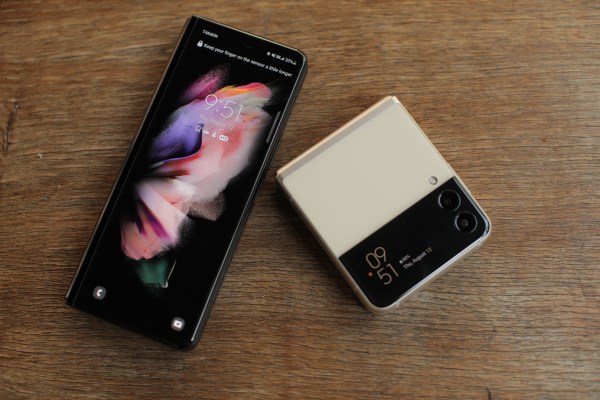Will foldables thrive in a post-pandemic world? – TechCrunch
Last week, Samsung killed the Note once and for all. It was a symbolic move. For all intents and purposes, the phone will live on as the Ultra tier of the company’s Galaxy S line. But it represents the end of an era for the decade-old brand. It’s also another opportunity for the company to assert its confidence in the foldables line — taking the mantle from the Note as its other mobile flagship.
For all of its stumbles out of the gate, Samsung is undoubtedly at the vanguard of foldable tech. Other firms have been in the category for nearly as long, but the Korean hardware giant was the first to crack the code and has seemingly invested far more resources into a category it sees as the future of mobile.
Samsung declared that foldables were more than a niche some time ago. Hell, I probably would, too, if I ran Samsung. Taken as part of the overall market, the answer is still definitively “yes.” For one thing, it’s still largely the domain of a single company (albeit a massive one) and still makes up a fairly small percentage of said company’s overall numbers.
I’ve seen plenty of projections of growth for the category from analyst firms over the past several years, but a new forecast from Canalys offers an interesting wrinkle in the numbers that I haven’t heard discussed all that much. Namely, will the pandemic lead to growth in the category?
It’s counterintuitive, to be sure. For starters, the pandemic has thus far had the opposite impact of smartphones. There are several reasons for this. The first and most obvious one is that people weren’t going out much early on, therefore making a new phone a bit superfluous. With the shutdowns came lost jobs and less disposable income, coupled with an already stagnant market, due to slower refresh cycles and higher costs. More recently, the chip shortage and supply chain issues have throttled the industry.
When people were spending money on electronics, it was things like PCs, as they adjusted to working from home. So, as things open up, could we begin to see the opposite effect?
“The key catalyst for foldable smartphones has been the booming use of large-screen devices during the pandemic,” Canalys’ Runar Bjørhovde said in a release. “As consumers are constantly looking for a better experience on their day-to-day mobile devices, the bar has now been set even higher by the productivity and entertainment experience on large screens. As the world continues to reopen, it brings new opportunities for smartphone vendors to provide products such as foldable smartphones that can fulfill consumers’ needs and desires.”
It’s an interesting theory, though one questions whether the world is more accustomed to large-screen devices than prior to the pandemic. The argument could be made that, in spite of not leaving our homes, we’re actually using our phones more.
“Most countries have imposed lockdown to break the chain of community transmission of this notorious virus, which has changed the way we are used to living in,” according to the authors of a study published last January. “Stay at home and work from home strategies are recommended worldwide as the most useful to prevent infection at both individual and community levels. This self-isolation has encouraged people to turn to their smartphones to stay connected increasingly.”
At this point, there’s little question that foldable numbers will continue to rise. Canalys specifically notes that 8.9 million foldables were shipped in 2021, a number it expects to increase north of 30 million by 2024. I suspect the pandemic will have an impact on those numbers, due, in part, to pent-up demand. A couple of years of delayed upgrade due to the pandemic and then supply chain issues will leave more consumers ready to buy a new handset and, perhaps, willing to pay a premium.
Another Canalys analyst (say that five times, fast) notes that the decline in premium device sales has driven more device makers to push for innovation at the high end. “Android vendors are under big pressure in the premium segment, as shipments of $800-plus smartphones have fallen 18% below the 2019 level while iOS shipments have grown 68% over the same time,” says Toby Zhu. “Google and the major Android device vendors must double down on their investments in differentiated hardware and state-of-the-art user experiences to keep appealing to high-end customers.”
Samsung’s relative success in the space has almost certainly broken the flood gates on that side of things. Oppo is probably the best example of this. The company’s Find N has fared well in early reviews, with many heralded as a foldable done right — a stark contrast to early attempts at the category from brands like Motorola. For me, last year’s Galaxy Z Flip was the first time I’ve truly considered a foldable in my own life. The form factor is more manageable than the Fold — as is the price.
More choice in form factors should drive interest, along with increased investment from the likes of Google. Having more devices in production, meanwhile, means lowered costs. Of course, even at a projected 30 million, the numbers still represent a drop in the bucket compared to overall smartphone shipments, which Counterpoint Research put at 1.39 billion in 2021.
Apple, as always, remains a big question mark in all of this. Rumors have surrounded a folding iPhone for years now, though estimates put a launch in 2023, at the earliest. The company is reportedly working to overcome production issues and is still attempting to decide whether or not to commercialize the product. Given how the first few foldables went, it’s hard to blame them.




